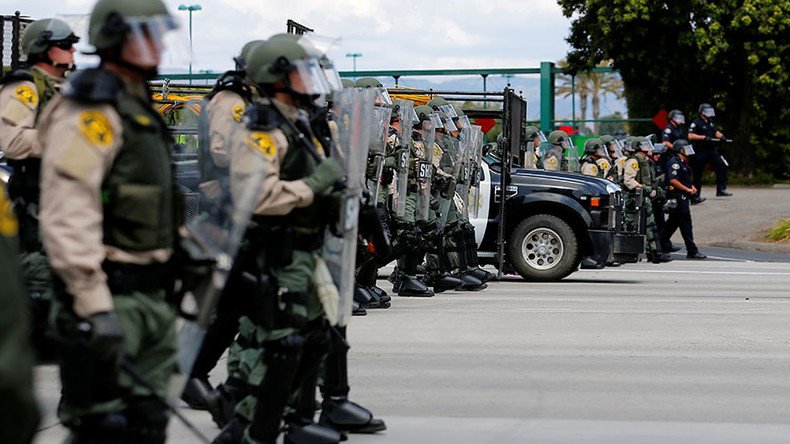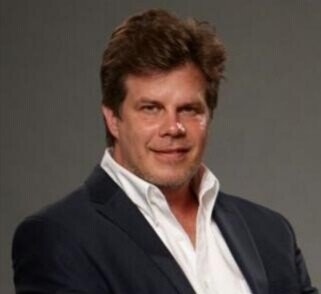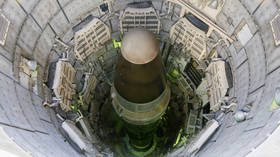Who will protect Main Street, USA from militarized police forces?

A radical transformation is occurring inside US society as local police, government agencies and even colleges are stockpiling military-grade weapons, as well as military training. How did this perilous scenario come to pass under a Democratic president?
Ironically, and potentially tragically, at the very same time Sheriff Obama seems determined to disarm Americans of their cherished Second Amendment, US police forces are steadily stockpiling an arsenal of weapons that would be the envy of many a foreign army. And those weapons are not just harmlessly gathering dust in the closet. Indeed, with alarming regularity the weapons, equipment and training are being put to use against the very citizens the police were meant to serve and protect.
In 2014, the ACLU released a startling report on the militarization of US police forces. In it, investigators examined the cache of weapons being collected by US states, which then distribute the hardware to localities. Here is a list of the military toys that just one state - Arizona - got courtesy of Uncle Sam: 32 bomb suits, 704 units of night vision equipment, 1,034 guns, of which 712 are rifles, 42 forced entry tools, such as battering rams, 830 units of surveillance and reconnaissance equipment, 13,409 personal protective equipment (PPE) and/or uniforms, 120 utility trucks, 64 armored vehicles, 4 GPS devices, 17 helicopters, 21,211 other types of military equipment.
Over 100 arrests made nationwide in Black Lives Matter protests https://t.co/dEomYz0TcVpic.twitter.com/rygq2HBnDG
— RT America (@RT_America) July 10, 2016
The immediate problem with handing over such massive firepower to state and local agencies is the same problem confronted by every military: Eventually those spanking new weapons, and regardless how lethal they are, will be used. Yet the Obama administration, which has had a full 8 years to address the issue, has let the problem fester to the point where trust - as witnessed by the tragic events in Dallas last week - has completely broken down between members of the American public and the police.
The argument I would like to make here, in light of the ongoing string of American tragedies, is that the militarization of the police - as opposed to the police officers themselves - is the real culprit. Our civil servants were never meant to be members of standing armies, working on behalf of faceless corporate entities.
Last year, according to an exhaustive report in the Washington Post, 990 Americans were killed by the police - more than two times the recently reported compilation of fatalities. Meanwhile, with over 500 US citizens already killed by the police this year, 2016 is on track to exceed last year’s recording-breaking tally by a wide margin.
Incidentally, lest we think police-related killings are simply a manifestation of race, the number of White Americans killed by police last year (494) was almost two-times the number of Black Americans killed in the same period (258). The investigative journalism group ProPublica, using FBI data from 1980 to 2012, reported that 44 percent of all those killed by police were in fact white.
If the police had more training on how to defuse potentially explosive situations instead of receiving military tactical training, would the streets of America be the better for it? I think the answer to the question is obvious.
Presently, citizens and police alike are being victimized by a system that recklessly throws a lot of military weapons and military training into communities in the belief that firepower alone will deter crime (which, in many cases, is symptomatic of a faltering economy). That militaristic approach has clearly failed. All things considered, it would be more helpful and less divisive for Americans to promote the idea that ‘Human Life Matters’ - as opposed to Black Lives, White Lives or What-have-you Lives - when considering the disturbing new phenomenon of police violence.
Tear gas, 102 arrested, 21 cops injured in Black Lives Matter protests in St. Paul (VIDEO) https://t.co/6fjuLH2b0rpic.twitter.com/VtTomANtHK
— RT America (@RT_America) July 10, 2016
How did we get here?
I am just old enough to remember the days when American neighborhoods were not the running battlefields many have become today, a less neurotic time when police resorting to armored vehicles, menacing weaponry and military tactics was the great exception not the rule. Observatory Hill, the diverse, middle-class Pittsburgh neighborhood where I enjoyed a crime-free childhood in the 1970s, is no longer remotely recognizable to me. A healthy, vibrant, God-fearing community just 30 years ago, Observatory Hill now plays occasional host to visiting SWAT teams searching for the latest drug pusher or violent offender.
These SWAT visits, however, are no longer reserved for hunting down the occasional criminal in the hood. Excessive police force is also being employed to crackdown on democratic demonstrations against the powers-that-be. To use my hometown of Pittsburgh yet again as an example, consider what happened in October 2009 amid a G-20 Summit. University of Pittsburgh students, protesting peacefully against the global movers and shakers, said they were subjected to heavy-handed police tactics that included the use of tear gas, pepper spray, rubber bullets and, freshly introduced for the first time in the US, sound cannons [officially known as the Long Range Acoustic Device, or LRAD, the only other time this device was reportedly used was by the US military in Iraq]. Nearly 200 people were arrested during the protests.
Bill Quigley, legal director of the Center for Constitutional Rights, explained in an interview with Democracy Now what he saw in Pittsburgh during the G-20.
“Well, we saw a heavily militarized town… The police really were supposed to be there for terrorists, and when no terrorists showed up, they turned their power and their toys, including this, first time in the United States, sound cannon, on protesters, and unfortunately, in the evenings, on the students… It was a complete overreaction. The people of Pittsburgh worked really hard to put on a good peace protest, to talk — challenge globalization, to talk about immigration, Iraq, Afghanistan and all these things. And the security forces were just totally out of hand.”
Following Pittsburgh’s no-contest showdown against Robocop, Boston got a glimpse of full-blown martial law following the 2013 Boston Marathon bombings in which three people died. Former Senator Ron Paul said the government’s over-the-top response to the attacks should frighten Americans more than the attack itself.
In an article entitled 'Liberty Was Also Attacked in Boston', Paul compared the door-to-door searches without warrants for suspect Dzhokhar Tsarnaev to “scenes from a military coup in a far off banana republic.”
“These were not the scenes from a military coup in a far off banana republic, but rather the scenes just over a week ago in Boston as the United States got a taste of martial law. The ostensible reason for the military-style takeover of parts of Boston was that the accused perpetrator of a horrific crime was on the loose. The Boston bombing provided the opportunity for the government to turn what should have been a police investigation into a military-style occupation of an American city,” Paul wrote.
The former US statesman could have been paraphrasing one of America’s Founders when he reminded: “We have been conditioned to believe that the job of the government is to keep us safe, but in reality the job of the government is to protect our liberties. Once the government decides that its role is to keep us safe… they can only do so by taking away our liberties. That is what happened in Boston.”
Benjamin Franklin was of a similar mind when he warned over 200 years ago: "Those who would give up essential Liberty, to purchase a little temporary Safety, deserve neither Liberty nor Safety."
#BlackLivesMatter may suffer the same fate as the Occupy movement [VIDEO] https://t.co/9pYOLcfm9M@LindsayFrance@real_alexm
— RT America (@RT_America) July 12, 2016
From the streets of Los Angeles to New York City, an increasing number of Americans are asking, as investigative reporter Radley Balko did in his 2014 book, ‘Rise of the Warrior Cop,’ how Americans came to inherit a system where “protests are met with flash grenades, pepper spray, and platoons of riot teams dressed like Robocops… and order is preserved by armed government agents too often conditioned to see streets and neighborhoods as battlefields and the citizens they serve as the enemy?”
The answer can be found in the National Defense Authorization Act (NDAA). Signed into law by President Bill Clinton on Sept 23, 1996, Section 1033 of the NDAA allowed for the transfer of excess military equipment to civilian law enforcement agencies.
The American public only started getting suspicious about the transformation of their police into something akin to a paramilitary outfit following the 2014 shooting of unarmed black teenager, Michael Brown, and the protests that erupted in Ferguson, Missouri thereafter. In response to the riots, police deployed armored MRAP (Mine Resistant Ambush Protected) assault vehicles and firearms, together with police that appeared better outfitted for a role in a Star Wars battle scene as opposed to a public protest in a suburb of St. Louis.
Forbes magazine put the police purchases into perspective: “Pentagon donations to the police reached $532 million in 2012 and $449 million in 2013. The figure has already topped $750 million in 2014…. A new MRAP sells for somewhere between $500,000 and $700,000 but law enforcement agencies are picking up these valuable beasts for free through the 1033 program.”
This inexplicable hoarding of guns and ammo presents not just a threat to the citizens of the United States. It also presents a real problem for the police themselves who are increasingly now looked upon with fear and loathing by many people who believe the police no longer uphold the motto to “protect and serve.” Better to de-militarize the police forces and let the US Army keep their lethal toys for themselves.
The statements, views and opinions expressed in this column are solely those of the author and do not necessarily represent those of RT.














